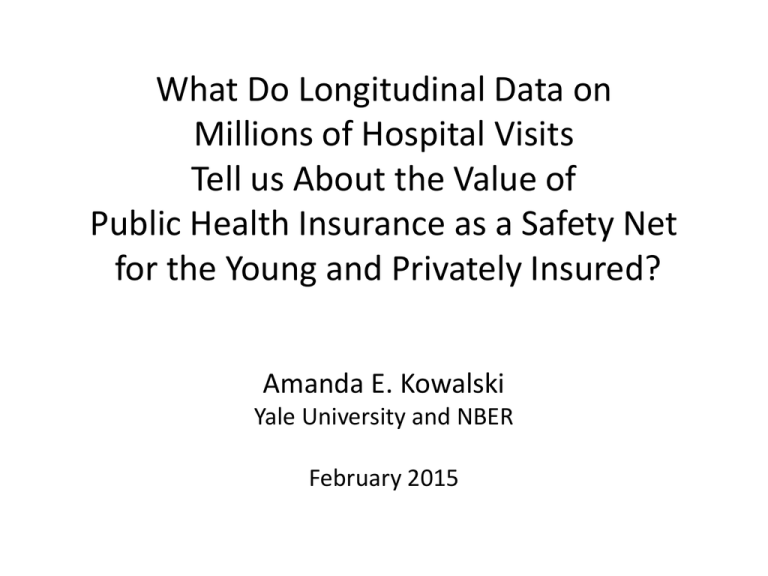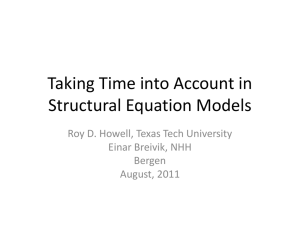Slides - Yale University
advertisement

What Do Longitudinal Data on Millions of Hospital Visits Tell us About the Value of Public Health Insurance as a Safety Net for the Young and Privately Insured? Amanda E. Kowalski Yale University and NBER February 2015 What Do Longitudinal Data on Millions of Hospital Visits Tell us About the Value of Public Health Insurance as a Safety Net for the Young and Privately Insured? • Young, privately insured individuals with hospital visits for diagnoses that require more hospital visits in future years are more likely to transition to public health insurance in future years • If we ignore the longitudinal transitions in the data, we miss over 80% of the value of public health insurance as a safety net What Do Longitudinal Data on Millions of Hospital Visits Tell us About the Value of Public Health Insurance as a Safety Net for the Young and Privately Insured? • What the prior literature does not tell us • What my data can tell us – stylized facts • How I incorporate my data into a framework for valuing public health insurance • What we learn from the framework, along with robustness The longitudinal value of health insurance is much greater than the sum of its cross-sectional parts The current private health insurance system does not offer long-term protection against financial risk • I consider the value of public health insurance as a “safety net” that fills gaps in the current private system – Previous literature focuses on design and regulation of private health insurance contracts to mitigate this risk • Cochrane (1995), Pauly (1995) • I use longitudinal data and a longitudinal framework – Previous literature focuses on the value of public heath insurance for those who have already been caught by it, using cross-sectional data and a cross-sectional framework • Medicare: Finkelstein and McKnight (2008), Khwaja (2010), Barcellos and Jacobson (2014) • Medicare Part D: Engelhardt and Gruber (2011) • Medicaid: Finkelstein, Hendren, Luttmer (2014) What Do Longitudinal Data on Millions of Hospital Visits Tell us About the Value of Public Health Insurance as a Safety Net for the Young and Privately Insured? • What the prior literature does not tell us • What my data can tell us – stylized facts • How I incorporate my data into a framework for valuing public health insurance • What we learn from the framework, along with robustness The longitudinal value of health insurance is much greater than the sum of its cross-sectional parts I use longitudinal data on almost all hospital visits in New York from 1995-2011 • Using my SPARCS data and population data, I create a balanced panel to represent New York State population • I focus on individuals who are young and privately insured in 1995 to isolate the value of the safety net Just for the stylized facts, I focus on individuals with “persistent diagnoses,” likely to drive the value of private health insurance as a safety net ICD-9 Diagnosis Code 403 282 277 707 710 340 250 414 595 345 295 555 Description Chronic Kidney Disease (hypertensive renal disease) Hereditary Anemia Cystic Fibrosis Ulcers Lupus Multiple Sclerosis Diabetes Heart Disease (Coronary Atherosclerosis) Urinary Tract Infection Epilepsy Schizophrenic Disorders Inflammation of Intestinal Tract Average Subsequent Years with Hospital Visits through 2011 4.9 4.7 3.6 3.4 3.4 3.2 3.1 3.1 3.1 3.0 2.9 2.9 Young, privately insured individuals with persistent diagnoses have higher costs in future years, and they are more likely to transition to public insurance in future years Even after imposing an annual upper bound of 17.9% of individuals with persistent diagnoses $30K, cumulative costs are $58K by 2011 for have public coverage in 2011, in contrast to 3.7% persistent diagnoses vs. 13K for other diagnoses with other diagnoses What Do Longitudinal Data on Millions of Hospital Visits Tell us About the Value of Public Health Insurance as a Safety Net for the Young and Privately Insured? • What the prior literature does not tell us • What my data can tell us – stylized facts • How I incorporate my data into a framework for valuing public health insurance • What we learn from the framework, along with robustness The longitudinal value of health insurance is much greater than the sum of its cross-sectional parts Simple indifference condition for valuing public health insurance • Rooted in frameworks used in the literature With public insurance Without public insurance • Closed form solution for ρ under CARA Goal: calculate how much we miss by using cross-sectional in lieu of longitudinal data • Special Cases of the Value of Insurance • Ratio of interest Contrast to other frameworks that produce the same value with cross-sectional or longitudinal data • Kowalski (2015) • Handel, Hendel, and Whinston (2013) The cross-sectional value of insurance from our framework φ is almost the same as the alternative cross-sectional value of insurance μ Implement the indifference condition empirically • Costs in actual world with public insurance: where: • Costs in counterfactual world without public insurance: where: • Uses all paths observed in the data, people with public coverage either gain private coverage or go uninsured • Examine robustness to wide range of parameters What Do Longitudinal Data on Millions of Hospital Visits Tell us About the Value of Public Health Insurance as a Safety Net for the Young and Privately Insured? • What the prior literature does not tell us • What my data can tell us – stylized facts • How I incorporate my data into a framework for valuing public health insurance • What we learn from the framework, along with robustness The longitudinal value of health insurance is much greater than the sum of its cross-sectional parts Longitudinal value of insurance much larger than cross-sectional value for a large range of risk aversion parameters Red dashed line shows traditional framework that gives the same answer for longitudinal And cross-sectional data Robustness to Parameters: α Across a broad range, lose over 90% of value Even though the levels vary a lot with α, the ratio stabilizes Rather than calibrating one value, consider robustness to a large range • All necessary parameters – α, coefficient of absolute risk aversion – M, upper bound for annual individual costs – T, number of years of data in sample – N, percentage of population in sample • Private Information on Persistent Diagnoses • Robustness to Including Uninsured Robustness to Parameters: M Across broad range, lose over 90% of value At very small values of M, there is not much risk, so all three values are close. We choose 30K as our baseline value because that is where the ratio stabilizes. As M gets really large, variability within a period increases while mean changes little, so cross-sectional value increases relative to risk-neutral value Both are small relative to longitudinal value – frequent visits dominate expensive visits Robustness to Parameters: T Across broad range, lose over 90% of value Use all years as our baseline value. Ratio stabilizes after about 8 years. MEPS only has 2.5 – not long enough for values to diverge. Robustness to Parameters: N Across broad range, lose over 90% of value Full sample contains 1.69 million individuals. MEPS is approximately 0.3% of our sample. Results at that size are highly variable. Results from 100 draws of the size of the MEPS range from 8.2% of 95.7% - too small for tails! Furthermore, this calculation assumes MEPS has 17 years of data, but it only has 2.5! Robustness to Private Information on Persistent Diagnoses Even with extreme private info, results persist Robustness to Including Uninsured These are baseline, somewhat less intuitive What Do Longitudinal Data on Millions of Hospital Visits Tell us About the Value of Public Health Insurance as a Safety Net for the Young and Privately Insured? • What the prior literature does not tell us • What my data can tell us – stylized facts • How I incorporate my data into a framework for valuing public health insurance • What we learn from the framework, along with robustness The longitudinal value of health insurance is much greater than the sum of its cross-sectional parts Appendix Slides Hospital Count – SPARCS vs. AHA Inpatient Cost – SPARCS vs. MEPS Insurance Coverage – SPARCS vs. CPS • Indifference condition with private information: • Closed form solution for λ: Robustness to Including Uninsured (cont.) • Theoretically possible for the longitudinal value of insurance ρ to be equal to zero, even if the risk neutral value of insurance λ is positive








